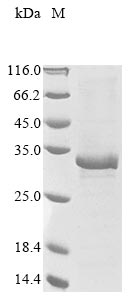In e.coli cells, the generation of the recombinant Human OSMR protein includes integrating a DNA fragment encoding the Human OSMR protein (762-979aa) into a plasmid vector and transforming this vector into e.coli cells. Cells containing the plasmid are screened, cultured, and induced to yield the OSMR protein. A N-terminal 10xHis tag and C-terminal Myc tag is attached to the protein. Lysis of the cells facilitates the collection of the recombinant Human OSMR protein, which is subjected to affinity purification and then SDS-PAGE analysis and subsequent staining of the gel with Coomassie Brilliant Blue. The purity of the obtained recombinant Human OSMR protein is greater than 85%.




